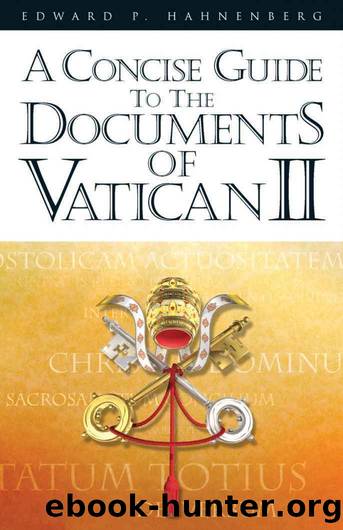A Concise Guide to the Documents of Vatican II by Hahnenberg Edward P

Author:Hahnenberg, Edward P. [Hahnenberg, Edward P.]
Language: eng
Format: epub
Publisher: St. Anthony Messenger Press
Published: 2011-08-09T16:00:00+00:00
7: DECREE ON THE TRAINING OF PRIESTS
Optatam Totius
The Decree on the Formation of Priests (OT) began as a sixty-page draft that called for the promotion of vocations and the reorganization of seminaries. By the time the bishops debated the document at the Council’s third session, it had been trimmed to four pages. At least in this case, the old adage was true: “less is more.”
The few critical voices raised in that debate came from those with the most to lose. The new text encouraged the decentralization of seminary education. No longer was universal uniformity the ideal. Bishops and bishops’ conferences should set up their own programs of priestly formation. This didn’t sit well with members of the Vatican’s Congregation for Seminaries and Universities—who until then had called all the shots. Other suggestions in the text (for example, greater attention to practical ministerial preparation, openness to alternative theological approaches, efforts to avoid isolating seminarians from the world) pushed seminary education in new directions. This was resisted by a few, but embraced by many. The document was overwhelmingly approved at the third session. And, after a modest enlargement, the Decree on the Training of Priests was formally promulgated at the Council’s fourth session (October 28, 1965).
Reading Guide
The longed-for (optatam) renewal of the whole (totius) church depends, in large part, on priests. OT sets out general guidelines for reforming priestly training in order to achieve this goal of renewal. While addressing all priests, its focus is on diocesan clergy— revealing the persistent slant of the Council itself toward parish- and diocesan-based ministry (as distinct from the types of ministry historically provided by various religious orders, such as missionary activity, itinerant preaching, retreats and so on).
General Principles and Local Adaptation (OT, 1–7)
The first section is the most important of the decree. Instead of the monolithic model of seminary education then in existence, OT encourages local episcopal conferences to develop their own programs of priestly formation attentive to the needs of their own churches ( OT, 1).
OT then underscores the need to promote vocations to the priesthood ( OT, 2). This is a duty of the whole community, from families to formal programs. Major seminaries (graduate-level education) play the primary role in preparing those men called to the priesthood ( OT, 4–7).
Holistic Education (OT, 8–21)
In addition to encouraging local adaptation, the second great contribution of OT is its holistic approach to seminary education. The document lays out three areas that need to be integrated in the formation of priests: the spiritual, intellectual and pastoral. OT’ s vision of spiritual formation is thoroughly Christ-centered. It is sensitive to the psychological factors at play in the development of a healthy minister. In terms of intellectual formation, the document calls for a revision of seminary curricula. The goal is to better integrate philosophy and theology ( OT, 14–15), to ensure a comprehensive engagement with the church’s tradition ( OT, 16), and to take advantage of new teaching methods ( OT, 17). Notable is OT’ s emphasis on the study of Scripture and its attention to other Christian communities and religions.
Download
This site does not store any files on its server. We only index and link to content provided by other sites. Please contact the content providers to delete copyright contents if any and email us, we'll remove relevant links or contents immediately.
Resisting Happiness by Matthew Kelly(3303)
The Social Psychology of Inequality by Unknown(2941)
Day by Elie Wiesel(2721)
Designing Your Life by Bill Burnett(2668)
The Giving Tree by Shel Silverstein(2290)
Human Design by Chetan Parkyn(2033)
Angels of God: The Bible, the Church and the Heavenly Hosts by Mike Aquilina(1932)
The Supreme Gift by Paulo Coelho(1903)
Jesus of Nazareth by Joseph Ratzinger(1769)
Hostage to the Devil by Malachi Martin(1757)
Augustine: Conversions to Confessions by Robin Lane Fox(1737)
7 Secrets of Divine Mercy by Vinny Flynn(1692)
Dark Mysteries of the Vatican by H. Paul Jeffers(1678)
The Vatican Pimpernel by Brian Fleming(1668)
St. Thomas Aquinas by G. K. Chesterton(1606)
Saints & Angels by Doreen Virtue(1579)
The Ratline by Philippe Sands(1517)
My Daily Catholic Bible, NABRE by Thigpen Edited by Dr. Paul(1465)
Called to Life by Jacques Philippe(1456)
